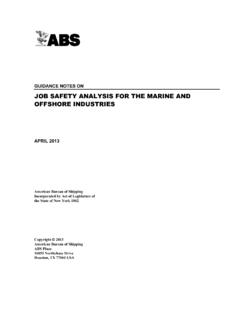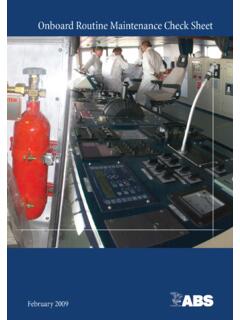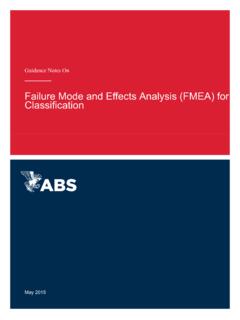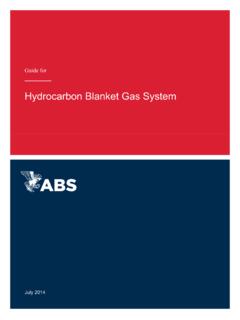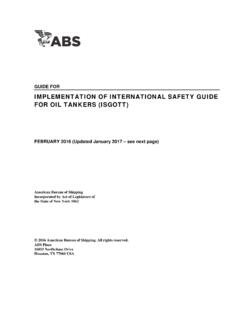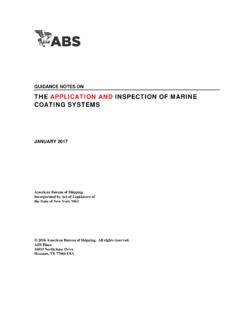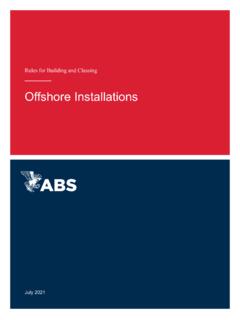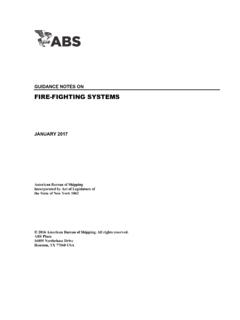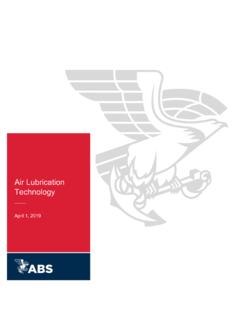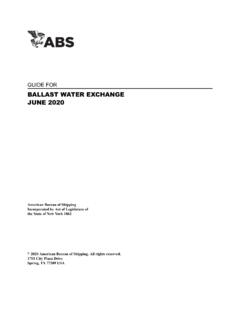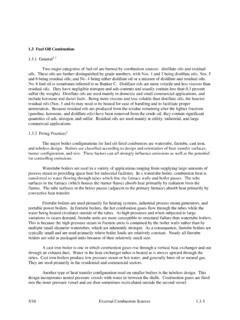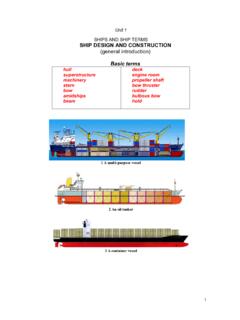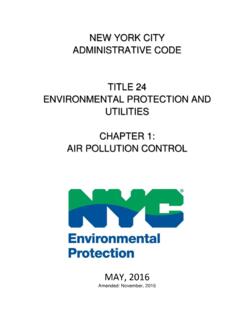Transcription of ABS Advisory on NOx Tier III Compliance
1 ABS Advisory . ON NOx tier III. Compliance . rodho/Shutterstock . TABLE OF CONTENTS. INTRODUCTION.. 1. SECTION 1 - EMISSION REQUIREMENTS .. 2. IMO Regulation .. 2. IMO tier III Exception.. 3. Emission Control Areas.. 4. Regional Emission Regulations.. 4. United States Regulation .. 4. California Air Resource Board Regulations.. 5. China.. 6. Norwegian Maritime Authority Regulations.. 6. Norwegian NOx Fund.. 7. IACS .. 7. ABS Rules.. 7. SECTION 2 - APPROVAL AND CERTIFICATION PROCESS.. 8. General .. 8. Statutory Approval.. 8. General:.. 8. Engine Pre-Certification.. 8. Engine with SCR for NOx tier III Compliance :.. 10. Retrofit of SCR to Onboard Engine for NOx tier III Compliance :.. 11. Class Approval .. 12. SECTION 3 - NOX REDUCTION TECHNOLOGIES.. 13. General .. 13. Selective Catalytic Reduction (SCR) .. 13. Principle of Operation.. 13. System Configuration .. 14. Consideration for SCR Application .. 14. Retrofitting of SCR for tier III Compliance .
2 16. Exhaust Gas Recirculation.. 16. Principle of Operation.. 16. System Configuration .. 17. Consideration for EGR Application.. 18. Dual Fuel and Gas Fueled (Otto) Engines.. 19. Principle of Operation.. 19. Consideration for Dual Fuel and Gas Fueled Engine .. 19. Other Potential Options.. 20. SECTION 4 - SHIPBOARD SUITABILITY AND COMPATIBILITY .. 22. Compatibility with Sulfur Compliance Options.. 22. Main Engine NOx Measurement and Amendment of NOx Technical File Due to SOx Scrubber Retrofit.. 22. EFFECT OF SCR ON EXHAUST GAS BOILER (EGB).. 23. Financial ASPECT .. 23. SECTION 5 - OPERATION CONSIDERATIONS.. 24. Auxiliary Control Device (ACD) and EPA Policy.. 24. Annual Spot Check Measurements for SCR Systems.. 25. tier II/III Changeover/on-off Recording Requirements .. 25. ABS SUPPORT .. 26. REFERENCES.. 27. APPENDIX I: FREQUENTLY ASKED QUESTIONS .. 28. LIST OF ACRONYMS.. 32.. INTRODUCTION. nitrogen Oxide (NOx) is one of the gaseous pollutants from ships regulated by the International Convention for the Prevention of Pollution from Ships (MARPOL Annex VI(1)), published by the International Maritime Organization (IMO).
3 Under Regulation 13 of MARPOL Annex VI, three tiers of nitrogen Oxide (NOx) emission limits are set for diesel engines with a power output higher than 130 kW, , IMO tier I, tier II and tier III. Each tier limits the NOx emission to a specific value based on the rated engine speed. Diesel engines for installation on a ship constructed on or after January 1, 2016 are subject to IMO tier III requirements when the ship is operating in a NOx tier III emission control area (NOx ECA) designated under Regulation 13 of MARPOL. Annex VI. The North American area and the United States Caribbean Sea area are currently designated as a NOx ECA. The Baltic Sea area and the North Sea are designated as a NOx ECA under MEPC. 286 (71)(2), to which the IMO NOx tier III requirements will be applicable from January 1, 2021. The air emission requirements are driving the development of primary engine technologies and secondary exhaust emissions abatement systems to reduce exhaust emissions from ships.
4 As a result, a number of techniques and design features are utilized by internal combustion engine manufacturers to reduce NOx emissions. The predominant technologies used to achieve Compliance with the IMO tier III limit include reduction of NOx emission at the source and the treatment of the exhaust gas after combustion. This ABS Advisory is developed to provide some of the best practices for IMO tier III Compliance for new builds as well as existing ships (retrofitted), including an overview of available technologies, consideration for the selection of Compliance options, process for statutory and class approval, practice for installation and integration, and challenges during operation. Some regional, national and local air emission requirements legislations impose limitations on the NOx emissions from ships in addition to the MARPOL regulations. This Advisory also provides information on the respective NOx emission limits, the geographic boundaries, and the Compliance criteria set by various authorities.
5 1 | Advisory ON NOx tier III Compliance | ABS.. SECTION 1 - EMISSION REQUIREMENTS. IMO REGULATION. The International Convention for the Prevention of Pollution from Ships, known universally as MARPOL, was adopted by IMO in 1973. In 1997, an IMO international conference of parties to MARPOL adopted the 1997 Protocol to the MARPOL. Convention which added a new Annex VI - Regulations for the Prevention of Air Pollution from Ships, based on the regulatory text developed by the IMO Marine Environment Protection Committee (MEPC). This Annex entered into force on May 19, 2005. The conference also adopted the Technical Code on Control of Emission of nitrogen Oxides from Marine Diesel Engines (NOx Technical Code NTC)(3). The new Annex VI introduced the first international shipping air pollution controls for Ozone Depleting Substances, nitrogen Oxides, Sulfur Oxides, Volatile Organic Compounds and shipboard incineration.
6 The Annex sets the general regulatory framework and limits for prevention of air pollution from ships with detailed requirements for survey, certification and means of control. The NTC provides the mandatory procedures for the testing, survey and certification of marine diesel engines to Regulation 13 that enables engine designers/ manufacturers, shipowner and operators to demonstrate and verify that all applicable marine diesel engines comply with the relevant NOx emission value limits. The NTC is in part based on the ISO 8178(4)~(9) series of standards for exhaust emissions measurement including test fuels, test cycles, measurement, reporting, and engine family or engine group definitions. To reduce the harmful effects of NOx emissions on human health and the environment, Regulation 13 of the MARPOL Annex detailed the limits for NOx emissions from diesel engines. Regulation 13. mandates that all marine diesel engines over 130kW installed on a vessels subject to MARPOL Annex VI are to comply with the IMO.
7 Applicable emission limit except engines solely used for emergency application such as engines for emergency generators, emergency fire pumps and engines installed in lifeboats. However, diesel engines used to drive external fire monitor pumps on firefighting vessels are not eligible for exemption unless advised otherwise by the Administration. Diesel engines installed in ships not engaged in international voyages may also be exempted provided such engines are subject to an alternative NOx control measure established by the Administration in whose waters the vessel is intended operate. Marine diesel engines are defined by IMO as any reciprocating internal combustion engine operating on liquid or gaseous or dual fuels, operating on Diesel combustion, or Otto combustion cycle, including gas fueled engines where gas/air mixture can be ignited by the combustion of a certain amount of fuel (pilot injection) or by extraneous ignition (spark plug).
8 The NOx emission limits are therefore also applicable to pure gas spark ignited engines. NOx formation is linked to peak combustion temperatures, and with inherently lower temperatures the natural gas burning engines that use the Otto combustion process in gas mode can meet the tier III NOx limits of Regulation 13 without exhaust emissions aftertreatment equipment. For more information on gas and dual fuel engines, and the differences between Diesel and Otto combustion cycles see the prime mover section of the ABS Advisory on Gas and Other Low Flashpoint Fuels. ABS | Advisory ON NOx tier III Compliance | 2. IMO ANNEX VI NOx LIMITS The IMO engine NOx limits are based on engine 18 rated speed (see Figure 1), with the lowest limits applicable to medium and high-speed engines. 16. tier I - 1 Jan 2000. The application date of the Regulation 13 NOx 14 n<130rpm = 17g/kWh 130rpm<n<2000rpm - 45*n^ emission limits is tied to the ship construction n>2000rpm = date.
9 NOx (g/kWh). 12. 10. The 58th IMO MEPC session in October 2008. 8 tier II - 1 Jan 2011 adopted further significant changes to Annex VI. n<130rpm = 130rpm<n<2000rpm - 44*n^ and the NTC under Resolutions (58)(10). 6 n>2000rpm = g/kWh tier III - 1 Jan 2016. and (58)(11) respectively. These changes 4. n<130rpm = 130rpm<n<2000rpm - 9*n^ entered into force on July 1, 2010. n>2000rpm = 2. The tier I NOx limit was retrospectively 0. 0 500 1000 1500 2000 2500. applicable to engines fitted to ships with keels Speed (rpm). laid on or after January 1, 2000 once Annex VI. entered into force on May 19, 2005. The 2008. amendments progressively reduced the NOx NOx calculated as total weighted emission Relative limits, with the tier II limit entering into force on RPM of NO2 (g/kWh) Reduction January 1, 2011. The amendments also introduced < 130 130 < n < 2000 > 2000 from tier I the tier III limit, which is only applicable in ECAs, tier I 45*n ( ).
10 0% and represents a NOx reduction of approximately 80% from the tier I limit. Where an SCR unit is tier II 44*n( ) - installed to comply with the IMO tier III NOx tier III 9*n( ) 80%. limits it is to be approved in accordance with the additional requirements of the IMO SCR. Figure 1: IMO MARPOL ANNEX VI Regulation 13 NOx Limits guidelines, currently as amended by (71)(12) and (74). IMO tier III EXCEPTION. Regulation of MARPOL Annex VI, as adopted by Resolution (66)(13), allows a five-year delay in the application of the tier III limits until January 1, 2021 for ships (generally applicable to large yachts) of less than 500 gross tonnage, with a length of 24m or over, that are specifically designed and used solely for recreational purposes. The proposal to pursue further delay of application of the tier III NOx requirements for such vessels beyond January 1,2021. was considered at the MEPC 74th session meeting.
